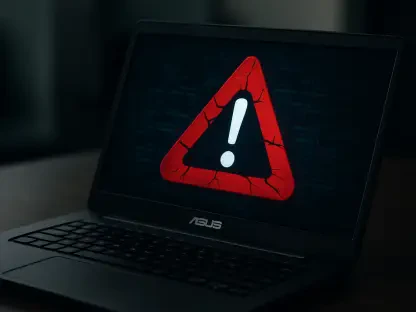Imagine a utility company managing power for millions of customers suddenly facing a cyberattack that disrupts service—not through a breach in operational technology, but via a forgotten SharePoint folder containing sensitive engineering diagrams. This scenario is not far-fetched in an era where collaboration platforms like Microsoft Teams, Google Drive, and Slack have become integral to critical infrastructure operations. While Chief Information Security Officers (CISOs) have long focused on securing industrial control systems, the sprawling data in back-office systems presents an equally dangerous attack surface. The hidden clutter in these platforms often holds a treasure trove of exploitable information, making it a prime target for nation-state actors and ransomware groups.
This guide aims to equip CISOs in critical infrastructure sectors with actionable strategies to combat data sprawl risks in collaboration tools, addressing an urgent and often overlooked cybersecurity challenge that threatens national security and operational integrity. By following the outlined steps, security leaders can identify vulnerabilities, govern sensitive data, and protect against evolving threats. The purpose of this resource is to shift focus toward these under-secured systems, providing a clear roadmap to mitigate risks that could otherwise lead to catastrophic disruptions.
The importance of tackling data sprawl cannot be overstated, especially as adversaries increasingly exploit legitimate tools to blend into normal operations, raising the stakes for utilities, pipeline operators, and similar entities. This guide offers a structured approach to secure back-office environments, ensuring they are treated with the same rigor as operational technology. Readers will gain insights into mapping data landscapes, enforcing governance, and implementing robust defenses, all while aligning with compliance mandates.
Understanding the Hidden Threat of Data Sprawl in Critical Infrastructure
Collaboration platforms have revolutionized workflows in critical infrastructure, enabling seamless communication and file sharing across teams, but the rapid adoption of tools like SharePoint and Microsoft Teams has led to an unintended consequence: data sprawl. This uncontrolled proliferation of information, often tucked away in forgotten folders or chat logs, escapes the scrutiny that CISOs typically apply to operational technology (OT) and industrial control systems (ICS). The result is a sprawling digital mess that adversaries can exploit as an entry point for attacks.
Despite the focus on protecting the so-called crown jewels of OT and ICS, back-office systems have emerged as a silent but potent threat. Sensitive data, ranging from engineering schematics to regulatory documents, often resides in these platforms without adequate oversight, posing a significant risk. The danger is not merely theoretical; attackers can leverage this clutter to map out entire infrastructures or steal critical information, turning a mundane file-sharing tool into a gateway for disruption. This vulnerability demands immediate attention from security leaders.
Addressing data sprawl requires a shift in perspective, recognizing that these platforms are not just tools for convenience but potential weak links in the security chain. The strategies outlined in this guide provide a starting point to uncover hidden risks and secure these environments effectively. By taking proactive measures, CISOs can prevent back-office clutter from becoming the Achilles’ heel of critical infrastructure, safeguarding both operations and national interests.
Why Back-Office Data Clutter Poses a National Security Risk
The widespread use of collaboration tools in critical infrastructure sectors, such as utilities and pipeline operators, has created a digital landscape ripe for exploitation, making security a pressing concern. As teams create countless sites, folders, and channels to share information, the volume of ungoverned data grows exponentially. Often, this includes highly sensitive content like customer personally identifiable information (PII), financial records, and detailed engineering plans that, if exposed, could provide attackers with a complete blueprint of an organization’s operations.
The implications of this data clutter extend far beyond internal disorganization, and for nation-state actors and ransomware groups, these platforms represent a goldmine of intelligence that can be weaponized to disrupt critical services. A single misconfigured folder or stale guest access link could grant adversaries the means to plan targeted attacks, potentially crippling power grids or halting pipeline flows. Such scenarios elevate data sprawl from a mere nuisance to a pressing national security concern that demands urgent action.
Moreover, the challenge of maintaining operational integrity and regulatory compliance adds another layer of complexity to the situation. Scattered data makes it difficult to produce evidence during audits or respond to incidents effectively, risking penalties and reputational damage. The convergence of these factors—security threats, operational risks, and compliance failures—underscores why back-office clutter is a critical issue. Ignoring it could undermine the very foundation of public safety and economic stability that critical infrastructure supports.
Strategies to Combat Data Sprawl: A Step-by-Step Approach
For CISOs in critical infrastructure, addressing data sprawl requires a systematic approach to uncover, classify, and secure information across collaboration platforms. The following steps provide a practical framework to reduce vulnerabilities and protect against sophisticated threats. By implementing these measures, security leaders can transform chaotic digital environments into well-governed systems that withstand adversarial scrutiny.
Each step focuses on a specific aspect of data management and security, ensuring comprehensive coverage of the issue. From identifying hidden risks to enforcing strict controls, the roadmap below equips professionals with the tools needed to tackle this pervasive challenge. The goal is to minimize the attack surface while maintaining the operational benefits of collaboration tools.
The process also emphasizes adaptability, recognizing that threats evolve over time, and as new risks emerge, continuous refinement of these strategies will be necessary to maintain security. This guide serves as a foundation for building resilient defenses, helping CISOs stay ahead of adversaries targeting back-office systems.
Step 1: Mapping the Data Landscape
The first step in combating data sprawl involves conducting a thorough audit of all collaboration platforms to understand the full scope of data distribution across an organization. This means cataloging information stored in tools like Google Drive, Microsoft Teams, and Slack, including files, metadata, and chat histories. Without a clear picture of where data resides, it becomes impossible to identify vulnerabilities or prioritize security efforts effectively.
Beyond basic inventories, mapping should reveal the nature of the content stored, as many critical infrastructure entities unknowingly house sensitive materials, such as SCADA runbooks or network diagrams, in unsecured locations. Tools that automate discovery can assist in this process, ensuring no corner of the digital environment is overlooked. This foundational step sets the stage for targeted risk mitigation.
Regular updates to this data map are essential as platforms and usage patterns change. New sites or channels may emerge, and old ones may fall into disuse, creating potential blind spots. By maintaining an up-to-date view of the data landscape, CISOs can ensure that subsequent security measures address current realities rather than outdated assumptions.
Identifying High-Risk Data Hotspots
Within the broader data landscape, certain areas pose heightened risks due to the sensitivity of the information they contain, such as engineering documents, customer PII, and privileged access details, which often lurk in misconfigured folders or over-shared channels. Using data loss prevention tools and classification software, security teams can pinpoint these hotspots for immediate attention.
Focusing on high-risk areas allows for efficient allocation of resources, ensuring that the most critical assets receive priority protection. For instance, a utility company might discover that substation layouts are stored in a publicly accessible SharePoint site, and identifying such issues early prevents potential exploitation by adversaries seeking to disrupt operations.
This process also involves assessing the context of data storage, as a seemingly innocuous file may contain embedded secrets, like passwords or API keys, that elevate its risk profile. By combining automated scanning with manual reviews, organizations can uncover these hidden dangers and address them before they become liabilities.
Addressing Unmonitored Access Points
Unmonitored access points, such as stale guest permissions, public sharing links, and outdated vendor accounts, create significant vulnerabilities in collaboration platforms. These entryways often go unnoticed, allowing external parties to view or download sensitive data without authorization. A comprehensive review of access controls is necessary to detect and close these gaps.
Automated tools can help identify permissions that no longer align with current needs, flagging accounts that have not been used in months. For example, a contractor’s access to a Box folder may persist long after their project concludes, posing an unnecessary risk. Revoking such access reduces the likelihood of unauthorized exposure.
Additionally, policies should be established to prevent future lapses in oversight. Requiring periodic reviews of sharing settings and disabling public links by default can minimize the chances of data falling into the wrong hands. This proactive stance ensures that access points remain tightly controlled across all platforms.
Step 2: Implementing Data Classification and Governance
Once the data landscape is mapped, the next step is to classify information based on its sensitivity and establish governance policies to manage it effectively. Classification helps distinguish between public, internal, and confidential data, ensuring that each category receives appropriate protection. This structured approach prevents misuse and overexposure of critical assets.
Governance policies provide the rules and processes needed to maintain order in digital environments, ensuring that operations run smoothly and securely. Without clear guidelines, employees may inadvertently store sensitive information in unsecured locations or share it with unauthorized parties. By embedding classification and governance into workflows, organizations can reduce human error and enforce consistent security practices.
Regular training on these policies is crucial to ensure compliance across all levels of the organization. Employees must understand the importance of labeling data correctly and adhering to retention schedules. Over time, this cultural shift toward data responsibility strengthens the overall security posture of critical infrastructure entities.
Building a Sensitivity Framework
A sensitivity framework categorizes data into distinct levels based on its potential impact if compromised, ensuring that appropriate security measures are applied. For instance, engineering diagrams might be labeled as highly confidential, while general meeting notes could be deemed internal. This system allows security teams to apply tailored controls, such as encryption or restricted access, to the most critical information.
Developing this framework requires collaboration between IT, legal, and operational teams to define criteria that reflect the organization’s unique risks, ensuring a comprehensive approach to data protection. For example, a utility might prioritize protecting grid layouts over marketing materials. Clear documentation of these categories ensures consistency in application across platforms.
Once established, the framework should be integrated into collaboration tools through automated tagging or manual labeling processes. This integration minimizes the burden on users while ensuring that data is handled according to its designated sensitivity. Periodic reviews of the framework keep it aligned with evolving threats and regulatory requirements.
Enforcing Lifecycle Management Policies
Lifecycle management policies dictate how long data should be retained and when it should be deleted, preventing unnecessary accumulation that expands the attack surface. For critical infrastructure, retaining outdated regulatory filings or employee records beyond their useful life creates clutter that adversaries can exploit, making systems more vulnerable to breaches. Setting clear schedules for archiving and deletion mitigates this risk effectively.
These policies must balance operational needs with security considerations. While some data, like historical maintenance logs, may need to be preserved for years, other data, such as temporary project files, can be purged sooner. Automated solutions can enforce these timelines, reducing reliance on manual intervention and minimizing errors.
Enforcement also involves monitoring compliance with lifecycle rules. Audits can reveal whether data is being retained inappropriately, allowing for corrective action. By reducing the volume of stored information to only what is essential, organizations can significantly lower their exposure to potential breaches.
Step 3: Securing Collaboration Platforms Against Threats
With data classified and governed, the focus shifts to deploying security controls that protect collaboration platforms from specific threats. Risks such as bulk data exfiltration, embedded secrets in files, and reconnaissance by adversaries require targeted defenses. This step ensures that even if attackers gain access, their ability to cause harm is limited.
Security measures must be both preventive and reactive, addressing vulnerabilities before they are exploited and responding swiftly to detected threats. Collaboration tools often have built-in features, such as permission settings, that can be configured for enhanced protection. Leveraging these capabilities alongside third-party solutions creates a layered defense strategy.
Regular updates to security configurations are necessary to address new attack vectors. As adversaries refine their tactics, CISOs must stay informed about emerging risks and adjust controls accordingly to ensure protection. This dynamic approach keeps platforms resilient against a constantly shifting threat landscape.
Restricting Oversharing and Sync Vulnerabilities
Oversharing, often through lax permissions or synchronization features, is a common vulnerability in collaboration platforms. Employees may inadvertently grant access to sensitive files via public links or sync tools that allow bulk downloads to personal devices, which can compromise security. Restricting these capabilities through strict sharing policies prevents unauthorized data exposure.
Configuring platforms to require approval for external sharing adds an extra layer of oversight, ensuring that sensitive information is protected from unauthorized access. Disabling risky sync features, or limiting them to trusted devices, further reduces the chance of data theft. These restrictions should be accompanied by user education to explain the rationale behind them, ensuring compliance without hindering productivity.
Monitoring sharing activities can also detect anomalies, such as a sudden spike in file downloads, that might indicate malicious intent. By combining preventive restrictions with active surveillance, organizations can minimize the risk of data leaving secure environments. This dual approach addresses both human error and deliberate exploitation.
Countering AI-Powered Exploitation
The rise of artificial intelligence as a tool for attackers introduces new challenges in securing collaboration platforms, and it is becoming increasingly difficult to protect sensitive information from sophisticated threats. AI can accelerate reconnaissance by mining unstructured data and metadata at scale, identifying valuable targets within sprawling systems. Defending against this requires advanced solutions that detect and disrupt automated exploitation attempts.
Behavioral analytics tools can flag unusual patterns, such as rapid file access across multiple folders, that suggest AI-driven attacks. Implementing rate limits on data queries or downloads adds friction to automated processes, slowing down adversaries. These measures must be fine-tuned to avoid disrupting legitimate users while still providing effective protection.
Staying ahead of AI-powered threats also involves anticipating future tactics. As these technologies evolve, security teams should collaborate with industry peers to share intelligence on emerging attack methods. This collective vigilance ensures that defenses remain robust against the increasingly sophisticated tools wielded by adversaries.
Step 4: Continuous Monitoring and Compliance Assurance
Securing collaboration platforms is not a one-time effort but an ongoing process that requires continuous monitoring to detect anomalies and maintain compliance. Without persistent surveillance, new vulnerabilities can emerge unnoticed, undermining previous efforts. This step ensures that security remains a dynamic priority rather than a static achievement.
Monitoring must be paired with mechanisms to enforce regulatory standards, particularly in critical infrastructure where compliance failures carry severe consequences. Scattered data can complicate audits, making it difficult to produce the required evidence. Organizing and securing information in line with mandates prevents such issues from arising.
Regular reporting on monitoring outcomes and compliance status keeps leadership informed of the organization’s security posture. This transparency enables swift decision-making when risks are identified. By embedding these practices into daily operations, CISOs can sustain a high level of protection over the long term.
Leveraging Automated Monitoring Tools
Automated monitoring tools play a vital role in identifying suspicious activity, such as unauthorized access or unusual data movement, in real time. These solutions can scan across collaboration platforms to detect deviations from normal usage patterns, alerting security teams to potential threats before they escalate. Their scalability makes them ideal for managing vast data environments.
Selecting the right tools involves assessing their ability to integrate with existing systems and provide actionable insights. For instance, a monitoring solution might flag a user downloading an unusually large volume of files, prompting further investigation. Customizable alerts ensure that notifications focus on the most relevant risks, avoiding alert fatigue.
Beyond detection, these tools should support incident response by logging detailed activity records. Such documentation aids in forensic analysis and helps demonstrate due diligence during regulatory reviews. Investing in robust monitoring capabilities is a cornerstone of maintaining a secure digital ecosystem.
Aligning with Regulatory Requirements
Compliance with regulatory standards, such as those governing data protection and record-keeping in critical infrastructure, hinges on organized data management. Collaboration platforms must store critical filings and records in a manner that is secure yet accessible for audits. Aligning data practices with these requirements not only helps avoid penalties but also reinforces trust with stakeholders.
This alignment involves mapping regulatory obligations to specific data categories and ensuring that governance policies address them. For example, customer PII might need to be encrypted and retained for a defined period under privacy laws. Automated classification and retention tools can streamline this process, reducing the risk of non-compliance.
Periodic assessments of compliance readiness are necessary to identify gaps before they become issues, ensuring that potential problems are addressed proactively. Engaging with legal and regulatory experts ensures that policies remain current with evolving mandates. This proactive stance not only mitigates risks but also positions organizations as responsible stewards of critical data.
Key Takeaways for Securing Back-Office Systems
This section distills the essential actions for tackling data sprawl into a concise list for quick reference:
- Map and audit data across all collaboration platforms to uncover hidden vulnerabilities and understand the full scope of exposure.
- Classify and govern data to prioritize security efforts and eliminate unnecessary clutter that expands the attack surface.
- Secure platforms with strict access controls and tailored protections against emerging threats like AI-driven exploitation.
- Monitor systems continuously and align data practices with compliance mandates to maintain a robust security posture.
Broader Implications: Data Sprawl in an Era of Evolving Threats
Data sprawl in collaboration platforms intersects with broader cybersecurity trends that are reshaping the threat landscape for critical infrastructure. Attackers are increasingly adopting “living off the land” tactics, exploiting legitimate tools to blend into routine operations, as seen in sophisticated campaigns targeting sensitive systems. This shift underscores the need to treat back-office environments with the same urgency as operational technology (OT) and industrial control systems (ICS), recognizing their role as potential entry points for disruption.
The growing influence of artificial intelligence as a force multiplier for adversaries adds another dimension to this challenge, making it a critical issue in modern security landscapes. AI enables attackers to process vast datasets and automate attacks at unprecedented speeds, turning sprawling data into low-hanging fruit. As these technologies advance, the scale of information stored in collaboration tools will likely increase, amplifying the risks if left unaddressed.
Looking ahead, potential regulatory shifts may impose stricter requirements on data governance in critical infrastructure, and CISOs must prepare for these changes by embedding flexibility into their security frameworks. Treating back-office systems as critical assets, rather than secondary concerns, is essential to staying resilient amid evolving threats and ensuring that defenses keep pace with adversarial innovation.
Final Call to Action: Protect Critical Infrastructure Now
Reflecting on the journey through this guide, it became evident that data sprawl in collaboration platforms poses a significant frontline security risk for critical infrastructure. The steps taken to map data landscapes, classify information, secure systems, and maintain compliance offer a robust foundation for mitigating vulnerabilities and ensuring safety. Each action contributes to transforming chaotic digital environments into governed, protected spaces.
Moving forward, the urgency to act remains paramount, as adversaries have likely already begun probing these systems for weaknesses, making it critical to respond swiftly and decisively. Security leaders need to prioritize the implementation of outlined strategies, ensuring that back-office data governance becomes a core pillar of their cybersecurity programs. Exploring partnerships with industry peers to share threat intelligence could further enhance preparedness.
Additionally, investing in advanced tools and continuous training for staff promises to bolster defenses against future risks. By committing to these next steps, CISOs solidify their role in safeguarding national security and operational resilience. The path ahead demands vigilance and adaptability, ensuring that critical infrastructure stands firm against the evolving tactics of determined attackers.









